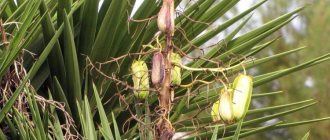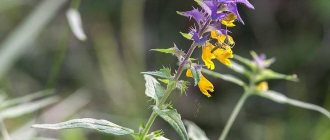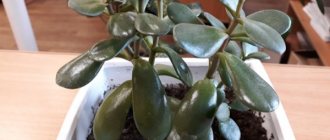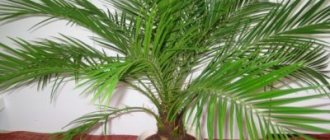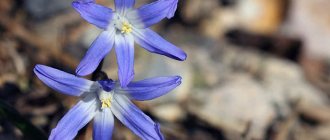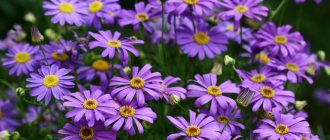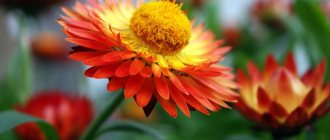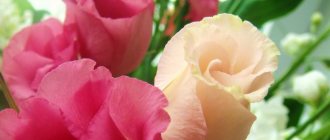Zamioculcas is a tropical plant from eastern Africa. Today it has spread all over the world, and this is due to its ease of care, but most importantly, its amazingly beautiful, decorative appearance. The flower is very often used in the design of modern interiors and perfectly complements even the most daring design solutions.
However, this plant not only has an interesting appearance, but also an equally fascinating history of its origin, and then its spread in indoor floriculture. Today this plant is known under such “folk” names as money tree or celibacy flower, and all these famous nicknames did not arise out of nowhere, but on the basis of many years of observations by different people.
Botanical description
The very first descriptions of Zamioculcas date back to the beginning 19th century . However, the plant received an accurate and generally accepted classification only in 1828, when the famous British botanist Conrad Loddiges described the structure and shape of Zamioculcas in his works. For the great similarity of the leaves of Zamioculcas with the already known at that time Zamia - a representative of the flora from the tropics of America - it was given the name Caladium Zamielifolia.
In 1856 the name of the flower was changed to Zamioculcas Loddiges. And only in 1908 it was finally renamed as it is known today - Zamiokulkas Zamielistny.
This plant is a succulent . The main reserves of water are stored in the roots. It is tuberous in shape with small shoots.
The plant develops thick, juicy evergreen leaves of regular shape. In different varieties they may differ in size: small but frequent or, conversely, large but rare. As a rule, they grow in a round shape.
The plant rarely reaches more than one and a half meters in height. Although in 2006 a decorative species was bred, which stops its growth, reaching only 40-50 cm in height.
Trimming
Pruning is not a prerequisite for proper plant care. It is carried out only to give it a certain shape or rejuvenation. You can trim any part of the plant: tuber, leaves, cuttings. The main thing is that the pruning tool is very sharp and sterile. A scalpel, garden pruning shears, and a sharp knife will do.
Also read: Lithops - amazing plants that look like stones
The cut area must be sprinkled with crushed activated carbon. This will quickly stop the leakage and block access to the “wound” for pathogenic microorganisms. Often pruning is used to treat the currency tree.
Plant structure
The most famous characteristic of Zamioculcas is its unpretentiousness. It is connected with the fact that the flower is classified as a succulent - that is, it has special tissues that store water in case of drought.
The bulk of the reserve moisture accumulates in the leaf cuttings, as well as in the root.
Roots
The roots of this flower are tuberous in shape with small lateral and lower shoots. It is in the tuber that the formation of most of the plant’s water reserves occurs.
They have a bright yellow or pale gray hue and form faster than the above-ground part of the flower. Zamioculcas strives first of all to entangle the entire earthen lump in the pot in order to quickly take water and nutrients from the soil, and only then directs the excess micro and macroelements obtained into the growth of green mass.
Leaves
The leaves are fleshy and dense.
At their base, closer to the root, moisture is stored in case of drought. The cuttings of each small leaf are attached to the false stem part, which rises vertically upward from the root. Interesting! In fact, Zamioculcas does not form stems at all.
In fact, leaves begin to grow from the root itself. They just have such a complex structure that some may get the impression that their base is the stem. The leaf blades are often formed quite small, which is why the flower itself has become so widespread in decorative floriculture. They retain their green color throughout the life of the flower. Only occasionally can leaves dry out and fall off, but this is either due to the plant being too dry (for example, it spends too much time in the sun) or insufficient watering.
It is also worth remembering that Zamioculcas leaves need to be wiped more often, as their waxy coating attracts dust. As an alternative method of cleaning a flower, some gardeners prefer water procedures - gently washing the plant under the shower.
Zamioculcas is a succulent plant. But its juice is very poisonous. For this reason, you should only cut leaves while wearing rubber gloves, and after every simple wiping of the flower, be sure to wash your hands. In its normal state, the plant is not capable of causing harm, but as a precaution, children or pets should not be allowed near it.
Note! If the juice gets on the skin or mucous membranes, the affected area should be immediately rinsed with warm water. If the juice gets into your mouth, it is better to take a couple of tablets of activated carbon. In case of a particularly severe reaction to the flower juice, it is recommended to consult a doctor as soon as possible.
Flowers
It is extremely difficult to achieve Zamioculcas flowering at home. To do this, you will have to achieve an almost ideal combination in terms of lighting, watering, fertilizing, and transplanting.
But the flowers themselves are quite discreet. They are a small ear of a dense white inflorescence, protected by a blanket of leaf blades.
Interesting! Due to the small attractiveness of Zamioculcas flowers, gardeners often immediately carefully cut off the formed flower so that it does not consume excess plant resources.
By the way, the shape of the flowers is very reminiscent of a human figure (the flower itself) dressed in a dress (the covering leaf blade). This is where symbolism found its place, because people began to call the plant the flower of celibacy, believing that the female owner of Zamioculcas would be able to get married only after flowering. Therefore, it is not customary to give it to unmarried ladies.
Fruit
It is difficult to get the money tree to bloom. Needless to say, it is even less common for a flower to bear fruit at home.
In nature, a single-seeded berry is formed from a flower. It is very similar in shape to a flower, but has a denser structure. In color, it is most often painted white or cream. But on some species the fruits are formed close to dark brown in color.
In indoor floriculture, almost no one succeeds in getting seeds to ripen. And the seed method of propagating Zamioculcas is rarely used. The fastest and easiest way to grow a new flower is from a cutting or a separated leaf.
Bloom
Diseases and pests of Zamioculcas
Zamioculcas Zenzi blooms with inflorescences; they consist of a spadix and a spathe, which appear at the very base of the leaves. The spadix is an inflorescence consisting of small flowers of light shades: milky, light cream or yellowish, which smell quite pleasant.
The flowers are heterosexual and are found in inflorescences separately from each other. Women's - from below, men's - from above. Between them there are sterile flowers, they create a zone of sterility. Its role is to prevent plants from self-pollinating.
When and how does it bloom?
The flowering period occurs in spring. First, a small peduncle is thrown out, and a light leaf appears from it, covering the inflorescence. The Zenzi flower itself is inconspicuous.
What do the fruits look like?
The inflorescence itself is inconspicuous; it is formed on a small fleshy stem.
Zenzi blooms rarely, and fruits appear even more rarely in the form of small brown berries, and the seeds practically never ripen completely.
Homeland of Zamioculcas
In the wild, Zamioculcas grows only in East Africa. The largest number of different varieties is recorded on the island of Madagascar.
The plant is most often found in the shade, although it can tolerate even severe drought. Some bushes can be found in full sun. Although the greatest species diversity is observed in the African steppes, rich in grass diversity.
Despite the tropical climate of its homeland, Zamioculcas is widespread in indoor floriculture even in the northern regions of the planet. Basically, this was due to the unpretentiousness of the flower, its ability to tolerate even extremely unfavorable conditions.
Today, Zamioculcas is very often an integral part of the decoration of modern interiors. It is valued for its exotic appearance, the evergreen nature of its leaves, and the dense, solid structure of the foliage that covers it.
The plant became most widespread after it began to be presented at numerous exhibitions starting from the end of the 20th century. Moreover, such exhibitions concerned not only floriculture, but also all kinds of interior solutions.
Adaptation after purchase
Now anyone can buy the Zenzi variety not only in stores, but also via the Internet. The plant is sent by mail in a special container. If in the first case the flower needs minimal adaptation, then after the postal flight it will need to be literally reanimated.
It is worth preparing a package of soil for cacti and succulents in advance, but the flower is not replanted immediately. First, it is placed in “quarantine” in a cool place without direct sunlight for 1-2 weeks. Only after this period, when it gets used to the microclimate of the room, can it be transplanted into new soil.
Interesting Facts
- Dollar tree is not the only popular nickname for Zamioculcas. It is also called the Tree of Luck, although for many people luck and money are concepts quite close to each other.
- But the plant also has a not so pleasant reputation. It is also popularly known as the flower of celibacy. It is believed that it attracts envious people and ill-wishers, so women are often afraid to keep Zamioculcas at home. On the other hand, they believe that after the flower blooms, all adversities are “reset.” However, the trouble is that flowering of this plant is difficult to achieve, and it occurs late, already at the end of Zamioculcas’s life.
- It is because of this unpleasant sign that if you want to give Zamioculcas as a gift, then it is customary to do this exclusively to men or married women.
Diseases and pests affecting this dwarf species
The most common diseases are:
- Root rotting occurs from low temperatures or frequent watering, as well as from stagnant moisture. Treatment: remove rotten roots, wash the rest in fungicide or potassium permanganate. Dry before planting.
- The yellowing of leaves is a natural process. But if later the leaves do not grow back, then the reason lies in the lack of watering or fertilizing; it is possible that the plant is standing in a draft. Treatment: remove the cause.
Pests:
- Aphids - treated with Fitoverm or Aktara.
- Spider mites - the plant should be treated with insecticides.
- Scale insects - remove with a damp swab or soap solution. It is best to use insecticides.
Zamioculcas Zenzi is an unpretentious plant with beautiful bright green leaves that will decorate any interior. It will delight its owner all year round.
Flower varieties
In natural conditions of the wild, only one species of Zamioculcas grows called Zamioculcas Zamielifolia.
The plant gained popularity for indoor cultivation at the end of the 20th century. People were attracted by the unusual shape of the leaves and the relative unpretentiousness of the flower. Today, several varieties of plants are the most widespread and are preferred for growing in homes, offices, and public spaces.
- Zamioculcas Lanceolata ( Lanceolata ) , the main feature of which is considered to be pronounced leaves with large blades in width and length.
- Zamioculcas Variegata . This is a rather rare variety, the main characteristic feature of which is the variegated color of the leaves, pointed at the edges. The variety grows up to 1-1.5 meters in height.
Also, for a long time, the variety Zamioculcas Buevena was isolated, which was later classified as a different genus of plants.
Landing rules
- Zamioculcas grows slowly. It is replanted once every two years, and an adult bush even less often. Take a pot that is strong and stable, 2-3 cm larger than the previous one.
- The succulent rhizome does not like damage, so they use the transshipment method without straightening or cutting the roots.
- The plant is provided with good drainage to avoid stagnation of water at the roots.
- The correct soil is loose, easily permeable to water and air.
Wear protective gloves during transplantation.
Plant care
You can cope with growing Zamioculcas at home without many years of experience behind you or any special skills or training. The thing is that despite its homeland in the tropics, the flower can withstand even serious adverse factors quite steadfastly. For example, he is not at all afraid of drafts, and is not even too whimsical in terms of watering. However, some subtleties of care are worth knowing. Otherwise, the plant will not look healthy and is unlikely to live long.
Interesting! Zamioculcas grow on average 5-10 years. The better the care, the longer the life expectancy.
Find out more about caring for Zamioculcas at home.
Watering
Although Zamioculcas has a tuberous root that can accumulate a lot of moisture, the flower needs to be watered regularly.
In summer, you should wait until the top of the soil dries out. If you follow these indicators, then the approximate and optimal frequency of soil moisture in the warm season is no more than 2 times a week. Some gardeners prefer to water Zamioculcas only once a week.
In winter, watering is expectedly reduced. It is believed that Zamioculcas will need one watering for 2 or 3 weeks.
Note ! If a flower is watered incorrectly, it begins to shed its leaves. Moreover, both with insufficient watering and excessive watering.
Reproduction
The dollar tree should be propagated under conditions close to its natural ones in the wild. The process is simple, but requires a certain skill, accuracy and knowledge.
You can propagate a dollar tree in three main ways: using a segment of a leaf, using a whole leaf, and dividing an adult, overgrown plant into parts. The methods differ radically in planting material and planting technology. Propagation from seeds is practiced extremely rarely by professional flower growers.
Be sure to carry out the propagation procedure with gloves. Juice from any part of the plant that comes into contact with the skin can cause irritation.
In suitable conditions, the dollar tree quickly takes root and easily takes root in a new pot and soil. At the same time, it is impossible to suddenly change the conditions of detention - gradual adaptation to new conditions is necessary.
The ideal time to propagate the plant is spring. Young tender leaves are not taken for planting; they do not yet have enough strength to take root. With proper care, the dollar tree will fully adapt by autumn, and the next season will actively begin to grow.
Reproduction using a feather leaf
Zamioculcas can be propagated using part of a leaf - a segment that is often mistaken for a separate whole leaf. Do not touch the youngest, not yet fully developed feathers - most likely they will simply die.
The segment is cut with a sharp knife or pruning shears. The cut site on the mother plant is immediately treated with charcoal to prevent the entry of bacteria. The cut segment is dried during the day from 5 to 12 hours, then it is also sprinkled with coal chips.
You can root a flower in water or a previously prepared moist substrate of peat and sand in proportions of 1 to 1. The container with planting material is covered with polyethylene or glass to create a greenhouse effect. The temperature should not fall below 20-22 degrees. The substrate must be regularly moistened and ventilated briefly to prevent waterlogging and souring.
During rooting, the leaf may turn yellow, devoting all its energy to the formation of the root system. After the appearance of firm roots and young leaves-buds, such a seedling can be planted in the soil. Be sure to use a drainage layer.
Propagation using a compound leaf
Rooting a complex leaf will be a little easier and faster than a separate segment. Unlike the first method, in this case a young leaf shoot is taken. Each leaf must have at least 2-5 segments. Leaves that are too old or too young will die.
Conclusion
Easy to care for, noble in appearance, slowly and correctly growing, Zamioculcas is now experiencing a real peak of popularity today. It really suits modern interior styles, which is why it has become widely used in the design of apartments, houses, offices, etc.
But the main feature is that Zamioculcas is famous for its unpretentiousness and the ability to absorb a large amount of moisture into the roots. This means that there is no need to monitor him sensitively and carefully.
In addition, among people there are signs associated with Zamioculcas or otherwise – the Dollar Tree. Since this flower is believed to bring financial well-being, this is another obvious feature why it can increasingly be found in gardeners’ collections.
Requirements for growing a dollar tree
Caring for the plant is simple. Loves warmth, bright light, moderate watering. The best place is a south window. You can place a flowerpot with a south-eastern or northern side, then the leaves will become a little smaller, but you will have to water the zamioculcas much less often. In summer, it is better to move the pot on the balcony. Landing nuances:
- The pet easily tolerates both moderate shade and bright sunlight.
- The plant survives in an extremely wide range of temperatures - from + 12 ° C in winter to + 30–35 ° C in summer.
- For replanting, you can take any soil, but not clayey soil. A bag of ready-made mixture for succulents or garden soil will do.
- drainage required.
- Zamioculcas grows very slowly indoors. It is necessary to replant the flower into a larger container when the current pot is filled with roots.
Conditions for growing a dollar tree

